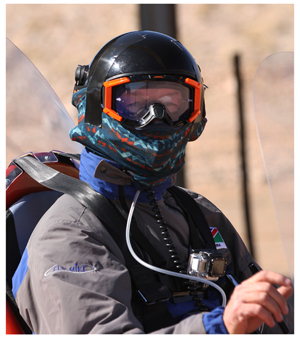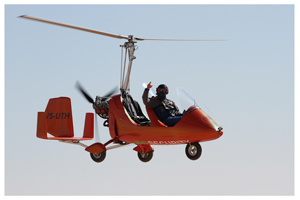
“It is halfway to heaven”
Dr Martin Wucher seconds before he started his take-off roll for an attempt to set a new altitude world record for open cockpit gyrocopters. One and a half hour later he exceeded both existing records for open and for enclosed cockpit gyros. Exhausted, exposed and exhilitated. One hour and forty seven minutes after departure, the daring gyro pilot homes in for a safe landing. As can be seen from the chart below, he reached 26663.7 feet above sea level before starting his descent. The chart that plots it all and that will eventually be crucial to have Dr Wucher’s attempt to break a world record, verified and recognised. The flight data starts on the left and progresses over distance and altitude towards the right up to point of maximum height. The chart shows that once this point was reached, a rapid descent followed with a slight hesitation at 12,000 feet, the altitude at which it becomes safe again for the pilot to breathe atmospheric air.
 Ultra-light V5-UTH above 26,000 feet
Ultra-light V5-UTH above 26,000 feet
A Namibian pilot who came within 2000 feet of a new altitude world record for gyrocopters in July this year, made a second attempt earlier this month, this time taking his gyro to 26663.7 feet above sea level.
Maverick Okahandja dentist, Dr Martin Wucher described his experience as spiritual saying “the air is dead quiet, clean and cold. You are on your own, alone with creation and you feel part of it. It is a unique experience. Like someone else remarked: It is halfway to heaven.”
Dr Wucher’s experience as a gyrocopter pilot started as a hobby. In August 2012 he bought an AutoGyro MTO Sport from AutoGyro Namibia. His instructor is Botha Jansen who has trained the majority of current Namibian gyrocopter pilots. Martin stays on a farm but runs a dental practice in Okahandja which afforded him the opportunity to use his gyrocopter to commute and to do farm patrols. This way he built hours quickly and it was not long before he chalked up more than 250 hours.
During the first few months, he was keen to test his new toy and briefly took the gyrocopter to a level of around 16,000 feet above sea level. But it was not until July this year that he made his first assault on the existing African record of 22,800 feet, At that stage the recognised world record for open cockpit gyrocopters was 26,4607 feet. While mentally planning his first attempt, he worked on his own proficiency as well as establishing the limits of his ultra-light aircraft. His AutoGyro MTO Sport is built by AutoGyro GmbH in Germany, and Martin wanted to match, through his own experience, the aircraft’s European specifications, with real conditions in Africa. He also started reading extensively on the do’s and don’ts of high altitude flying. Before long he was convinced that the record could be matched and even improved given the ideal flying conditions in Namibia.
His July attempt was done at the Rostock Ritz airstrip, famous for its annual desert fly-in for owners of light aeroplanes. He had to make special provision for oxygen and protective clothing. The gyrocopter is an open-cockpit aircraft and at that height, the temperature is between minus 25 and minus 45 degrees Celsius. With windspeed of about 80 knots through the open cockpit, any exposed skin suffers frostbite within minutes. So, on 26 July 2013, Martin flew to a height of 24,111 feet as measured by his on-board GPS. For this first attempt, all the requirements for later claim and verification of a new world record, were not in place, but it provided the daring pilot first with an indication what his aircraft is capable of, and secondly, a real-time experience in flying conditions that high up. It paved the way for the second, formal attempt to break the world record, and then to have this record officially recognised and ratified by the Federation Aeronautique Internationale.
In the meantime Martin had to take care of technical considerations covering both his aircraft’s performance and his own survival. He had to reckon with the effect of altitude and temperature on the output capacity of the engine, and he had to protect himself against depleted oxygen intake and the severe cold at altitude.
By tweaking the payload envelope he was able to reduce gross take-off weight by 11 kg. The propeller was replaced with a Neuform 3 Blade with variable pitch and optional manual trim. It was flown partly at constant speed setting of 5700 RPM. Above 22,000 feet pitch was regulated manually.
For the intended world record flight, oxygen was supplied by nasal canulae covered by a standard clear oxygen mask. This was done to enrich incoming oxygen and to prevent loss of oxygen supply should he not breathe through the nose. Blood oxygen was monitored continuously by an Edan pulse oxymeter. In his sleeve pocket he carried a back-up oxygen meter for an emergency. During the flight he would breathe pure oxygen at a rate of 2 to 5 litre per minute. Before the flight he was on pure oxygen for 30 minutes to flush out nitrogen. This technique is recommended to reduce dissolved nitrogen in the blood and thus the chance of decompression sickness as he ascends.
Early on the morning of 04 October 2013, Martin and his support crew started their preparations targeting 07:00 for take-off. His erstwhile instructor, Botha Jansen was on the scene accompanied by the rest of the Jansen family taking care of technicalities and ensuring that all pre-flight checks are done. His mask and protective clothing was taped down with duct tape.
Also on the airfield that morning were representatives from AutoGyro GmbH as well as two of the factory’s main sales partners in Russia and the United States.
Fitting and checking the instrumentation that would log airspeed, altitude, location and duration took some time and he took off at 07:25. These instruments are required to log the data that eventually will determine the success of the application to have his new world record officially recognised.
Climbing to 13,000 feet was uneventful at 100% power setting and an average climb rate of 845 feet per minute. At that stage the turbo lost its effect due to the thin air and climbing was continued at maximum power. He kept in touch with base by radio every two minutes relaying information about the vitals of both aircraft and pilot.
The climb rate slowed from about 20,000 feet but continued steadily to 25,000 feet. At that stage pitch control was switched to manual to be able to balance engine RPM, forward speed and manifold pressure. With that technique, climbing continued slowly and peaked at 26,663 feet. The top was reached at 09:03 AM. It had taken 1 hour and 30 minutes to get there.
Martin opted for a fast decent employing a so-called power hover. Engine RPM was kept constant at 4000 rpm, letting the gyrocopter descend vertically under its own weight. This technique keeps the engine warm and assures a quick descent to levels where oxygen can be breathed normally. A power hover over 22,000 feet is probably another world first.
It still took him another 17 minutes to reach the ground at an average rate of descent of 1350 feet per minute.
At the highest point in the curve, he was more than 8 kilometres above ground level. If this record is ratified it will be the highest-ever recorded flight in any gyrocopter, either enclosed or open cockpit.
Afterwards he was asked the inevitable question: Was he ever scared seeing that there is zero room for mistakes?
He was however confident that his extensive preparations as well as the ability of the gyro would pay off. He said he had rehearsed the entire flight in his mind many times before the actual attempt.
“I was in a flow state, knowing what to expect and keeping my focus on what needs to be done during the almost two-hour trip,” he said.












































